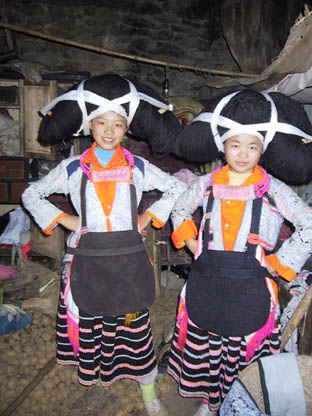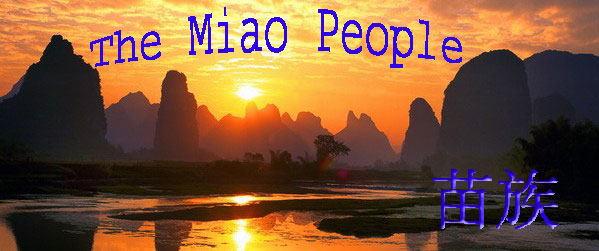|
The
History of the Miao people
With a
population of more than seven million, the Miao people form one of the
largest ethnic minorities in southwest China. They are mainly distributed
across Guizhou, Yunnan, Hunan and Sichuan provinces and Guangxi Zhuang
Autonomous Region, and a small number live on Hainan Island in Guangdong
Province and in southwest Hubei Province. Most of them live in tightly-knit
communities, with a few living in areas inhabited by several other ethnic
groups.
On the Yunnan-Guizhou Plateau and in some remote mountainous areas, Miao
villages are comprised of a few families, and are scattered on mountain
slopes and plains with easy access to transport links.
Much of the Miao area is hilly or mountainous, and is drained by several big
rivers. The weather is mild with a generous rainfall, and the area is rich
in natural resources. Major crops include paddy rice, maize, potatoes,
Chinese sorghum, beans, rape, peanuts, tobacco, ramie, sugar cane, cotton,
oil-tea camellia and tung tree. Hainan Island is abundant in tropical
fruits.
As early as
the Qin and Han dynasties 2,000 years ago, the ancestors of the Miao people
lived in the western part of present-day Hunan and the eastern part of
present-day Guizhou. They were referred to as the Miao in Chinese documents
of the Tang and Song period (A.D. 618-1279).
In the third century A.D., the ancestors of the Miao went west to
present-day northwest Guizhou and south Sichuan along the Wujiang River. In
the fifth century, some Miao groups moved to east Sichuan and west Guizhou.
|
|
In the ninth century,
some were taken to Yunnan as captives. In the 16th
century, some Miao settled on Hainan Island. As a result of these
large-scale migrations over many centuries the Miao became widely dispersed.
Such a wide distribution and the influence of different environments has
resulted in marked differences in dialect, names and clothes. Some Miao
people from different areas have great difficulty in communicating with each
other. Their art and festivals also differ between areas.
|
 |
Language
The Miao
language belongs to the Miao-Yao branch of the Chinese-Tibetan language
family. It has three main dialects in China -- one based in west Hunan, one
in east Guizhou and the other in Sichuan, Yunnan and part of Guizhou. In
some places, people who call themselves Miao use the languages of other
ethnic groups. In Chengdu and Suining in Hunan, Longsheng and Ziyuan in
Guangxi and Jinping in Guizhou, about 100,000 Miao people speak a Chinese
dialect. In Sangjiang in Guangxi, over 30,000 Miao speak the Dong language,
and on Hainan Island, more than 100,000 people speak the language of the
Yaos. Due to their centuries of contacts with the Han people, many Miao can
also speak Chinese.
|
Costume
Their
clothing has distinctive features which vary from place to place. In
northwest Guizhou and northeast Yunnan, Miao men usually wear linen jackets
with colourful designs, and drape woollen blankets with geometric patterns
over their shoulders. In other areas, men wear short jackets buttoned down
the front or to the left, long trousers with wide belts and long black
scarves. In winter, men usually wear extra cloth leggings known as puttees.
Women's clothing varies even from village to village. In west Hunan and
northeast Guizhou, women wear jackets buttoned on the right and trousers,
with decorations embroidered on collars, sleeves and trouser legs. In other
areas, women wear high-collared short jackets and full- or half-length
pleated skirts. They also wear various kinds of silver jewellery on festive
occasions.
|
|
In
southeast Guizhou, west Hunan, Rongshui in Guangxi and on Hainan Island, the
Miao eat rice, maize, sweet potatoes and millet as staple foods. In
northwest Guizhou, Sichuan and northeast Yunnan, they mainly eat maize,
potatoes, buckwheat and oats. In southeast Guizhou, Miao cooks make a sour
mixture of glutinous rice and vegetables by packing them tightly into jars
for up to two months.
Because timber resources are plentiful in most Miao areas, houses are
usually built of wood, and roofed with fir bark or tiles or are thatched. In
central and western Guizhou, houses are roofed with stone slabs. Houses vary
greatly in style. In mountainous areas, they are usually built on slopes and
raised on stilts. Animals are kept under the stilted floors. In the Zhaotong
area in Yunnan and on Hainan Island, most Miao live in thatched huts or
"branch houses," made of woven branches and twigs or bamboo strips plastered
with mud.
The typical Miao family is small and monogamous. Aged parents are usually
supported by their youngest son. In some areas, a son's name is followed by
his father's, but generally a Miao person uses only his or her own name.
Influenced by the Han feudal patriarchal clan system, the Miao made efforts
to maintain their family pedigrees, built ancestral halls and adopted words
in their names to indicate their position in the family hierarchy.
Marriages are usually arranged by parents, but unmarried young men and women
have the freedom to court. Mass courting occasions sometimes take place
during holidays, when young women from a host village gather to sing
antiphonal love songs with young men from neighbouring villages. If a couple
are attracted to each other, they exchange love tokens. But they must still
win the approval of their parents before they can marry.
In Chuxiong, Yunnan Province, the practice of setting up public courting
houses for unmarried men and women prevailed until a few decades ago. After
a day's work, they would visit these houses to sing, dance and court with
their partners. The Miaos there also practiced the custom of "kidnapping
brides." If the kidnapped girl consented to an offer of marriage, a grand
wedding feast was held. If she did not, she was free to go.
Different Miao communities celebrate different festivals. Even the same
festivals may fall on different dates. In southeast Guizhou and Rongshui
County in Guangxi, the Miao New Year festival is celebrated on "Rabbit Day"
or "Ox Day" on the lunar calendar. The festivities include beating drums,
dancing to the music of a lusheng (a wind instrument), horse racing and
bull-fighting. In counties near Guiyang, people dressed in their holiday
best gather at the city's largest fountain on April 8 of the lunar year to
play lusheng and flute and sing of the legendary hero, Yanu.
In many areas, the Miaos have Dragon Boat festivals and Flower Mountain
festivals (May 5), Tasting New Rice festivals (between June and July), Pure
Brightness festivals and the Beginning of Autumn festivals. In Yunnan,
"Stepping over Flower Mountains" is a popular festivity for the Miao.
Childless couples use the occasion to repeat vows to the god of fertility.
They provide wine for young people, who sing and dance under a pine tree, on
which hangs a bottle of wine.
Young men
and women may fall in love on this occasion, and this, it is hoped, will
help bring children to the childless couples.
The Miao used to believe in many gods, and some of their superstitious
rituals were very expensive. In west Hunan and northeast Guizhou, for
instance, prayers for children or for the cure of an illness were
accompanied by the slaughter of two grown oxen as sacrifices. Feasts would
then be held for all the relatives for three to five days.
Culture
The Miao
have a highly diversified culture developed from a common root. They are
fond of singing and dancing, and have a highly-developed folk literature.
Their songs, which do not rhyme and vary greatly in length from a few lines
to more than 15,000, are easy to understand and are very popular among the
Miao.
The lusheng is their favourite musical instrument. In addition, flutes,
copper drum, mouth organs, the xiao (a vertical bamboo flute) and the suona
horn are also very popular. Popular dances include the lusheng dance, drum
dance and bench dance.
The Miao create a variety of colourful arts and crafts, including
cross-stitch work, embroidery, weaving, batik, and paper-cuts. Their batik
technique dates back 1,000 years. A pattern is first drawn on white cloth
with a knife dipped in hot wax. Then the cloth is boiled in dye. The wax
melts to leave a white pattern on a blue background. In recent years,
improved technology has made it possible to print more colourful designs,
and many Miao handicrafts are now exported.
| |
 |
|
|





